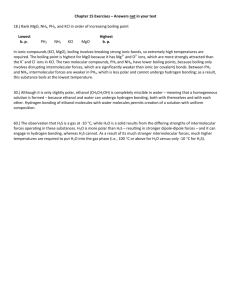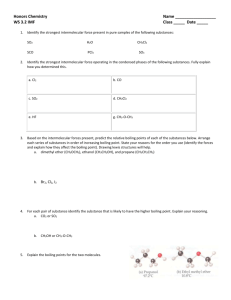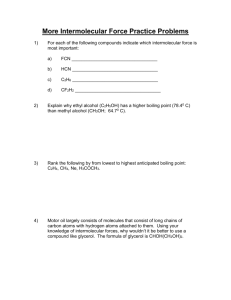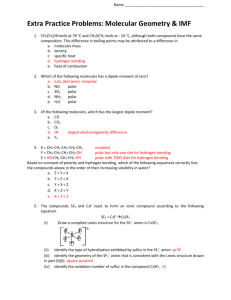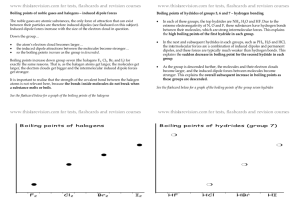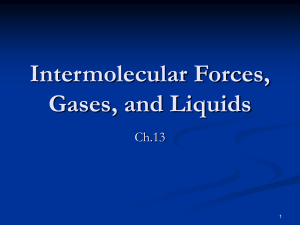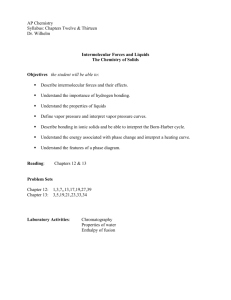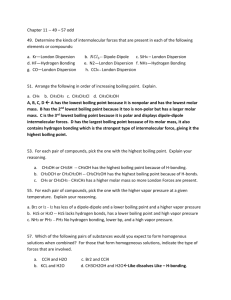Chapter 10: Intermolecular Attractions
advertisement
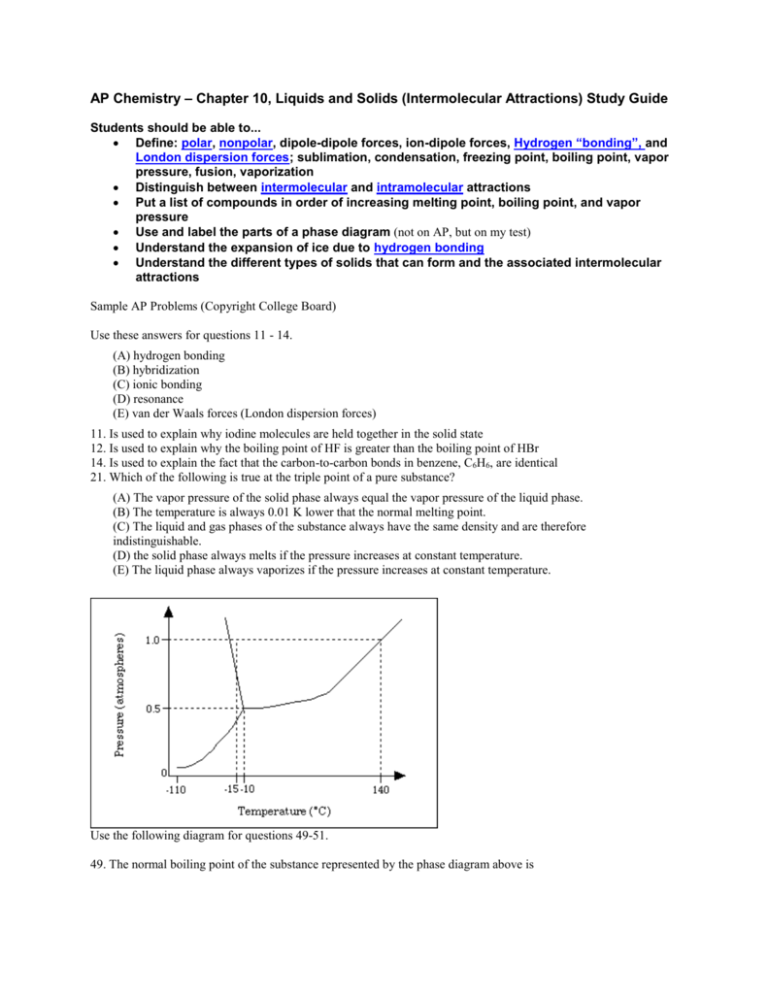
AP Chemistry – Chapter 10, Liquids and Solids (Intermolecular Attractions) Study Guide Students should be able to... Define: polar, nonpolar, dipole-dipole forces, ion-dipole forces, Hydrogen “bonding”, and London dispersion forces; sublimation, condensation, freezing point, boiling point, vapor pressure, fusion, vaporization Distinguish between intermolecular and intramolecular attractions Put a list of compounds in order of increasing melting point, boiling point, and vapor pressure Use and label the parts of a phase diagram (not on AP, but on my test) Understand the expansion of ice due to hydrogen bonding Understand the different types of solids that can form and the associated intermolecular attractions Sample AP Problems (Copyright College Board) Use these answers for questions 11 - 14. (A) hydrogen bonding (B) hybridization (C) ionic bonding (D) resonance (E) van der Waals forces (London dispersion forces) 11. Is used to explain why iodine molecules are held together in the solid state 12. Is used to explain why the boiling point of HF is greater than the boiling point of HBr 14. Is used to explain the fact that the carbon-to-carbon bonds in benzene, C6H6, are identical 21. Which of the following is true at the triple point of a pure substance? (A) The vapor pressure of the solid phase always equal the vapor pressure of the liquid phase. (B) The temperature is always 0.01 K lower that the normal melting point. (C) The liquid and gas phases of the substance always have the same density and are therefore indistinguishable. (D) the solid phase always melts if the pressure increases at constant temperature. (E) The liquid phase always vaporizes if the pressure increases at constant temperature. Use the following diagram for questions 49-51. 49. The normal boiling point of the substance represented by the phase diagram above is (A) -15 °C (B) -10 °C (C) 140 °C (continued on next page) (D) greater than 140 °C (E) not determinable from the diagram 50. The phase diagram above provides sufficient information for determining the (A) entropy change on vaporization (B) conditions necessary for sublimation (C) deviations from ideal gas behavior of the gas phase (D) latent heat of vaporization (E) latent heat of fusion 51. For the substance represented in the diagram, which of the phases is most dense and which is least dense at -15 °C. Most Dense Least Dense (A) Solid Gas (B) Solid Liquid (C) Liquid Solid (D) Liquid Gas (E) The diagram gives no information about densities. 1992 free response (Copyright College Board) 8) Explain each of the following in terms of atomic and molecular structures and/or intermolecular forces. (a) Solid K conducts an electric current, whereas solid KNO3 does not. (b) SbCl3 has a measurable dipole moment, whereas SbCl5 does not. (c) The normal boiling point of CCl4 is 77 °C, whereas that of CBr4 is 190 °C. (d) NaI(s) is very soluble in water whereas I2(s) has a solubility of only 0.03 gram per 100 grams of water. Answers to AP problems Multiple Choice Answers: E, A, D, A, C, B, D Free Response 8) average score = 3.0 a) two points K conducts because of its metallic bonding or "sea" of mobile e's (or "free" e's) KNO3 does not conduct because it is ionically bonded and has immobile ions (or imm. e's) b) two points SbCl3 has a measurable dipole moment because it has a lone pair of e's which causes a dipole or its dipoles do not cancel or it has a trigonal pyramidal structure or clear diagram illustrating any of the above SbCl5 has no dipole moment because its dipoles cancel or it has a trigonal bipyramidal structure or clear diagram illustrating either of the above c) two points CBr4 boils at a higher T than CCl4 because it has stronger intermolecular forces (or van der Waals or London dispersion). These stronger forces occur because CBr4 is larger and/or has more electrons than CCl4. (Note added to scoring standard: student misconception of inter-, with "inter-" double underlined.) d) two points NaI has greater aqueous solubility than I2 because NaI is ionic (or polar) whereas I2 is nonpolar (or covalent). H2O, being polar, interacts with the ions of NaI but not with I2. (Like dissolves like accepted if polarity of H2O clearly indicated.)

